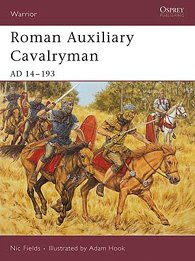I am an old, grumpy emperor and, often when I read a new book, I am easily irritated.
Chiefly, I dislike badly written books. I realise that different writers have different styles, but there's no excuse for poor grammar. Here's an example: "The pride of the Roman cavalry was the horsemen of the alae." The subject of this sentence is plural -- there were lots of horsemen in the alae -- so the verb must be plural, too. The pride of the Roman cavalry were the horsemen of the alae. See? That's a lot better. (By the way, alae is just a technical term for the Roman cavalry regiments.)
I also dislike inaccuracy, which can take many forms from 'typos' to outright factual errors. For example, the Latin word tironis does not mean "recruits"; Roman socks were not called undones; and the Latin plural of lancea (a lance) is not lancae. (Before you reach for your Wheelock, the correct answers are: tirones, udones, and lanceae.)

Trustworthy?
All of these mistakes were extracted from the latest book to land on my desk: Roman Auxiliary Cavalryman AD 14-193. (That's the title on the cover; on p.1, the inside title-page, it's called "Roman Auxiliary Cavalry". At least the author's name is spelled correctly.)
The Latin mistakes I'm willing to classify as simple gaffes (although I am suspicious of their recurrence, along with others, in the book's glossary). Another example -- the Latin document known as De munitionibus castrorum ("About fortifying camps") is repeatedly cited as De muntionibus castrorum -- might just be a publisher's typo. But there are more fundamental errors that should perhaps have been nagging at the back of the author's mind as he wrote them.
As an exemplar for a typical cavalry regiment name, he gives us the ala Gallorum et Thracum Classiana invicta bis torquata civium Romanorum. He tells us that it was formed in AD 21. (How does he know?) He tells us that its first commander was a Gallic nobleman called Classicianus! (If its title "Classiana" really does indicate the founder, then his name was Classius, not Classicianus!) He tells us that it transferred from Britain to Germany in AD 122. (True, we have no evidence of it in Britain after AD 122, but that's not proof that it left the province in that year.) And so it goes on.
Review
If I were writing a book review, I'd tell you the basic breakdown of the book. So, after a brief "Introduction", there are short sections on
- "Recruitment" : Table 1 on p.7, labelled "Cavalry recruitment", details "Numbers" totalling 39,500 from 11 provincial areas, but doesn't really explain what this represents (Recruits in a year, maybe?) ;
- "Organization" : if a cavalry "troop" (turma) is consistently given as 30 men + 2 officers, why isn't the infantry century (centuria) given as 80 men + 3 officers?;
- "Equipment and Appearance" : we are told the weight of a pair of boots (!) but not the weight of a helmet, which seems slightly more important;
- "Training and Exercises" : I know it's nit-picking, but surely Xenophon's Greek text is called Peri hippikes, not Peri Hippikis (and Arrian's Techne taktike has been mangled by the typesetter);
- Conditions of Service : short sections on pay, rewards, and diet;
- Military Life : in the military calendar of celebrations, the "festivals associated with the leading deities and members of the imperial family" were not called dies imperii! ;
- On Campaign : short sections on rations, fodder, before battle, and during battle ; and
- After Service : it seems odd that honourable discharge was granted "only after a thorough medical examination" !
Easily irritated?
I think my enjoyment of a book is inversely related to the number of times I have to mentally correct the text, like a belated proof-reader. I'd like to know more about Roman cavalry, but there must be a less stressful way to do it!